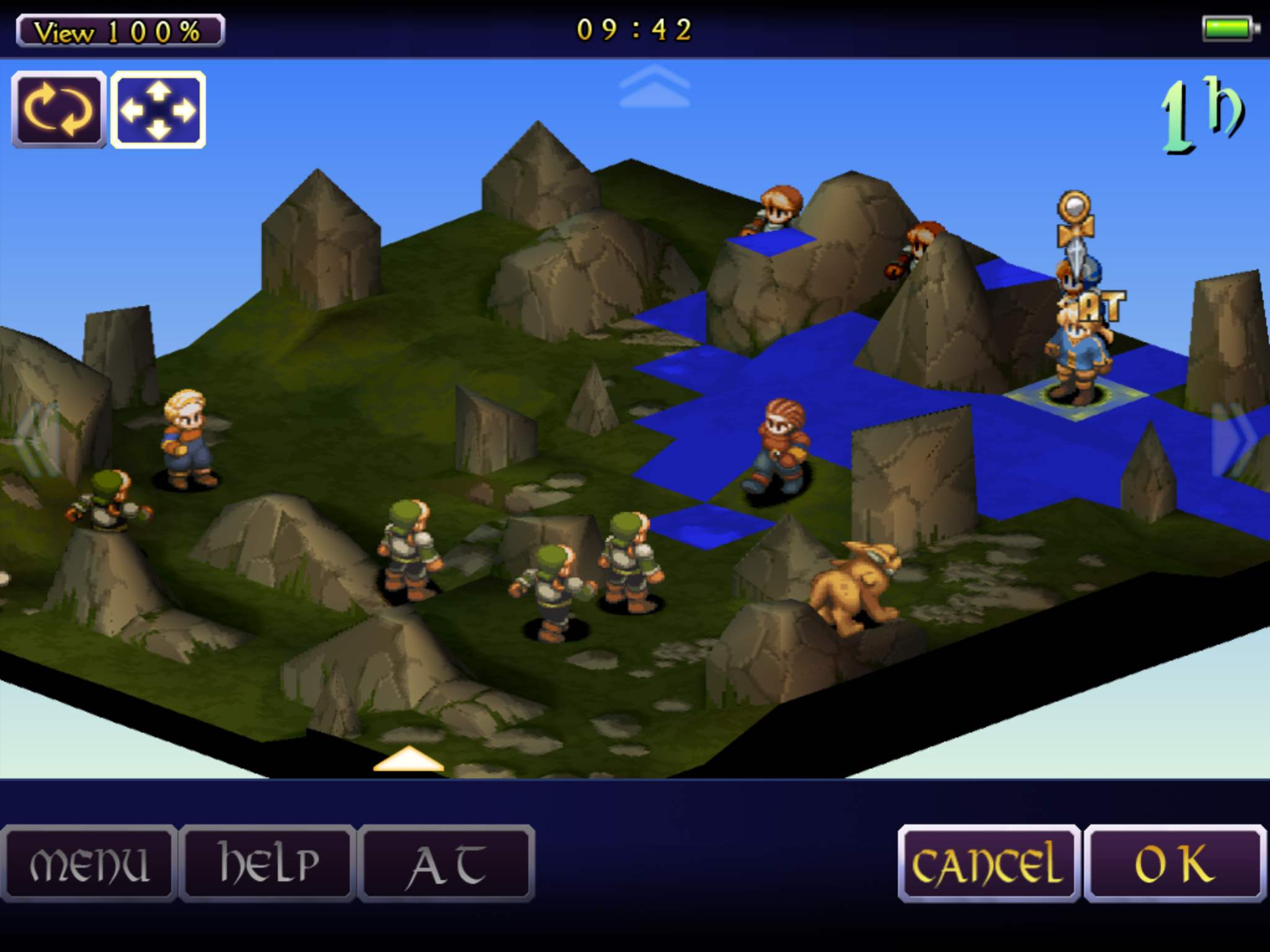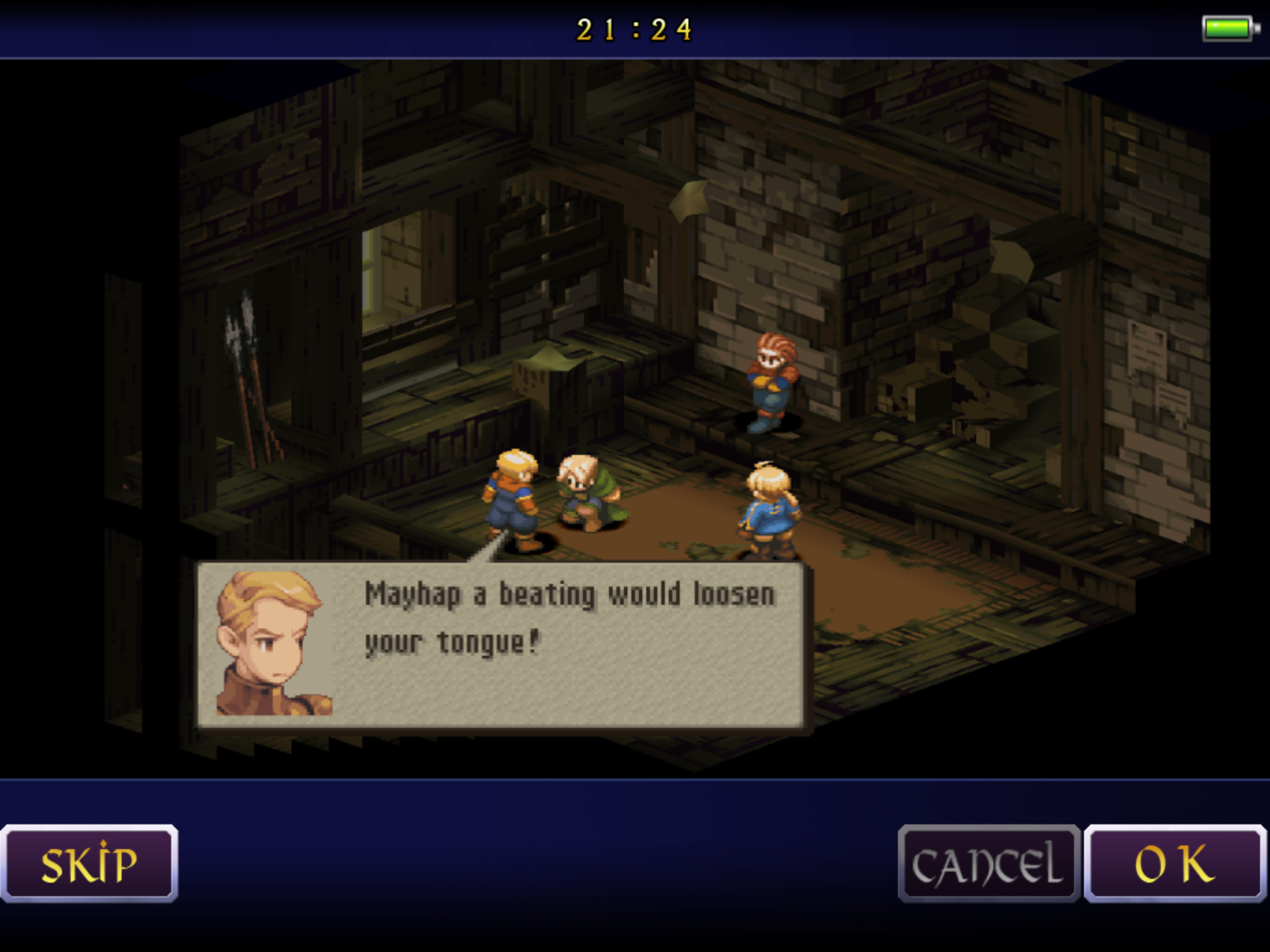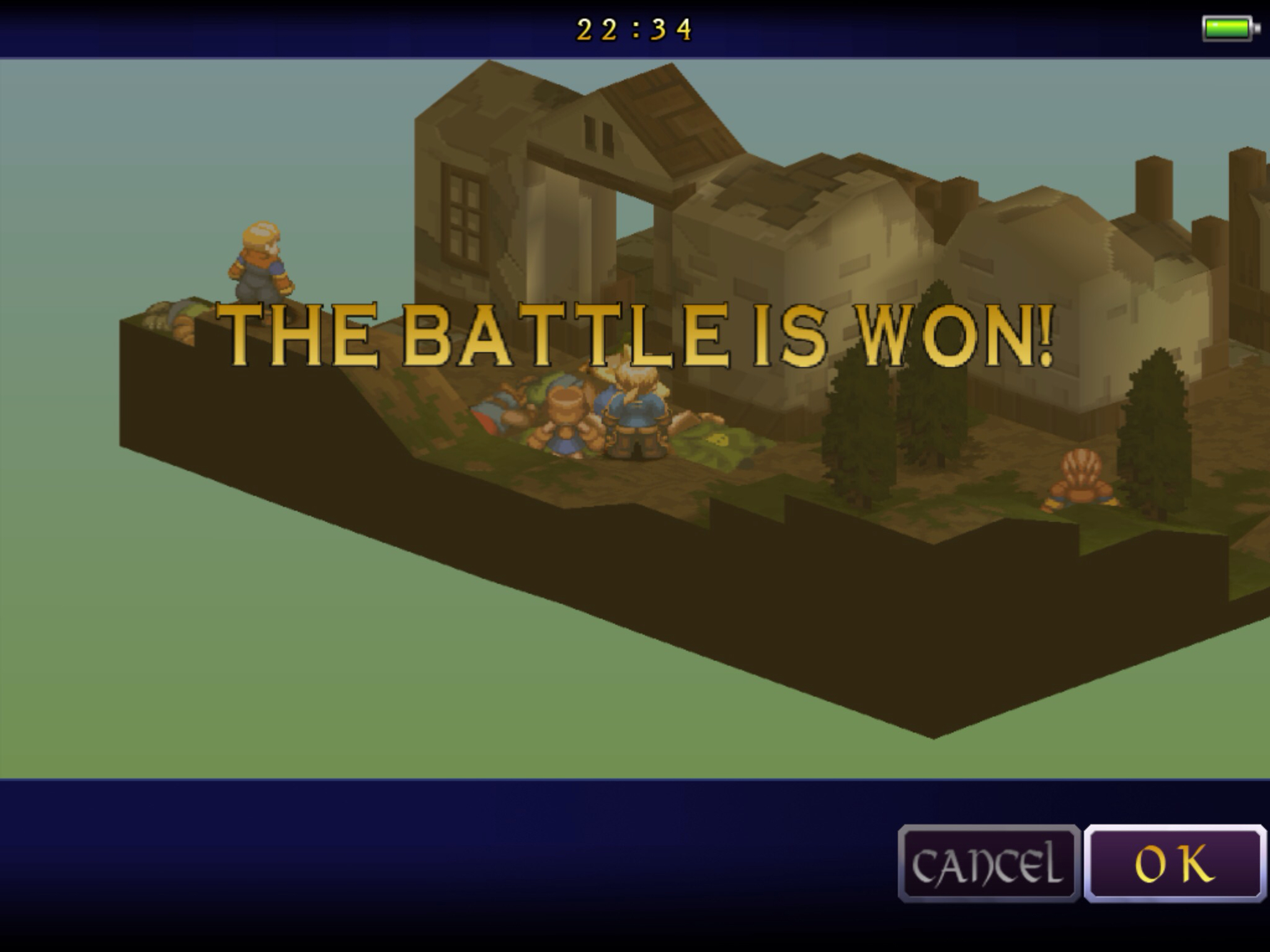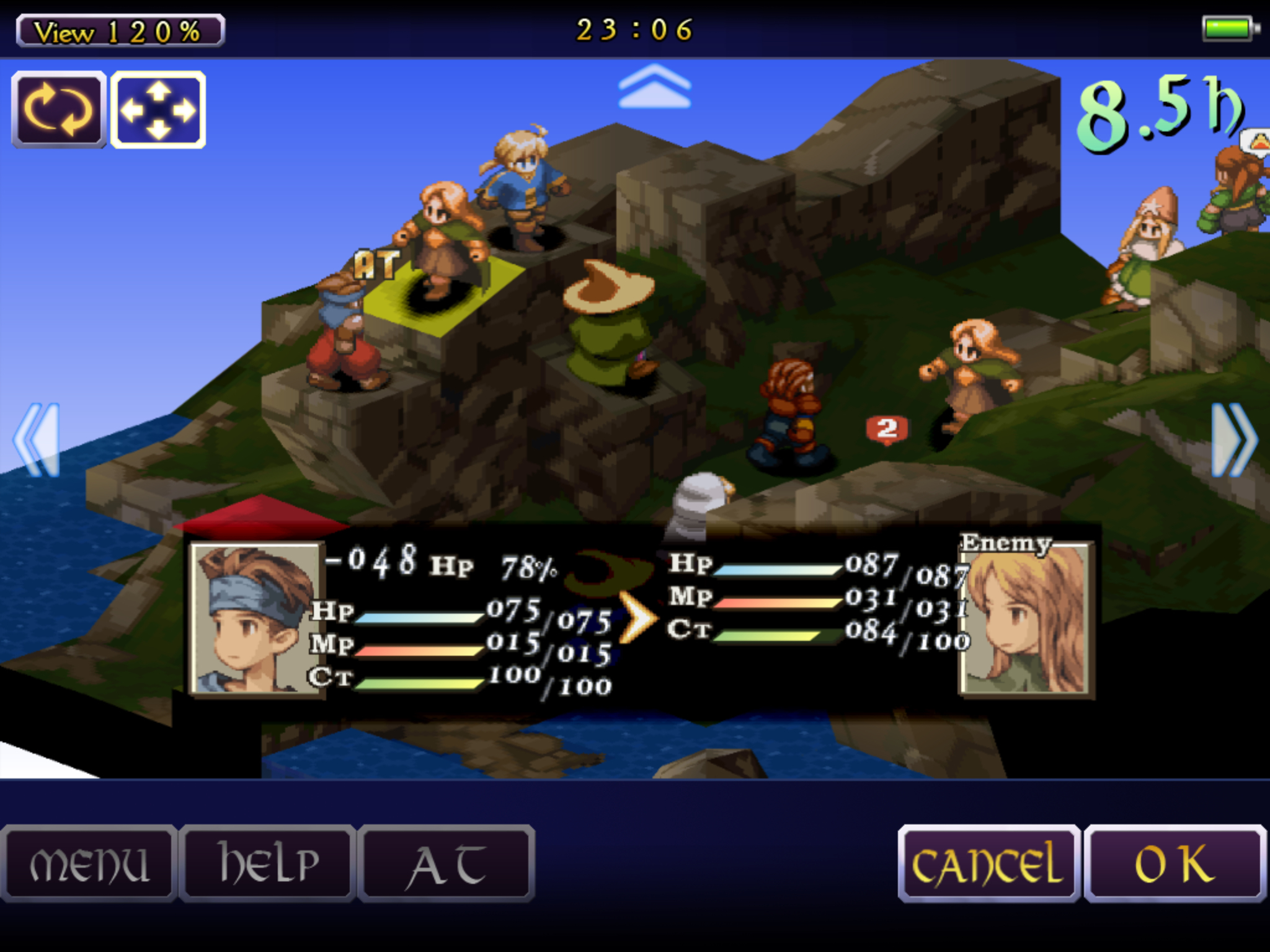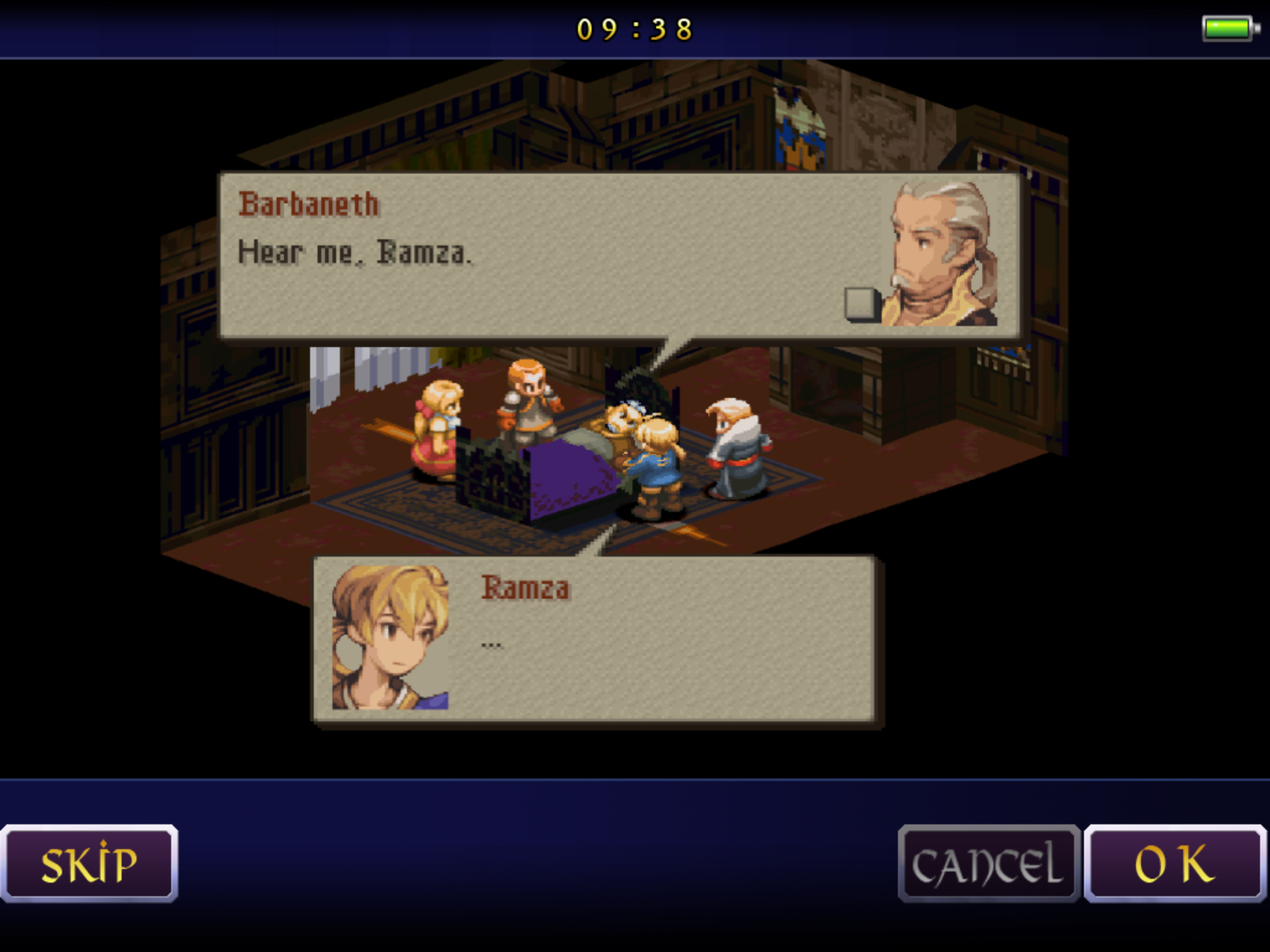 Hello, gentle readers, and welcome to the RPG Reload, the weekly feature where birth and faith wrong us, not Delita. Each week, we take a look at an RPG from the App Store’s past for a little revisiting, a little reflection, and even a cheery bit of fun now and then. RPGs of all stripes are welcome here, and I try to plan out a fairly balanced schedule covering the four corners of this broad genre. I look to you, the friendly readers, to assist me with that by choosing one game each month for me to play and write about. Simply comment below, post in the Official RPG Reload Club thread, or tweet me at @RPGReload to let me know what you’d like to see in the next reader’s choice article. I’ll choose one of the suggestions randomly and much entertainment will be had by all. The next reader’s choice RPG Reload is next week, which means I have a winner to announce. I’ll be playing Adventure Bar Story ($2.99), suggested by readers Zepfhyr and Curtisrshideler. Thanks for voting, friends! Now, everyone get voting for the March reader’s choice feature. No rest for the wicked!
Hello, gentle readers, and welcome to the RPG Reload, the weekly feature where birth and faith wrong us, not Delita. Each week, we take a look at an RPG from the App Store’s past for a little revisiting, a little reflection, and even a cheery bit of fun now and then. RPGs of all stripes are welcome here, and I try to plan out a fairly balanced schedule covering the four corners of this broad genre. I look to you, the friendly readers, to assist me with that by choosing one game each month for me to play and write about. Simply comment below, post in the Official RPG Reload Club thread, or tweet me at @RPGReload to let me know what you’d like to see in the next reader’s choice article. I’ll choose one of the suggestions randomly and much entertainment will be had by all. The next reader’s choice RPG Reload is next week, which means I have a winner to announce. I’ll be playing Adventure Bar Story ($2.99), suggested by readers Zepfhyr and Curtisrshideler. Thanks for voting, friends! Now, everyone get voting for the March reader’s choice feature. No rest for the wicked!
This week’s game has been frequently requested since the very start of this series of articles, but never quite had enough votes to win. Worry not, I hear you, even if your choice doesn’t get selected formally. I was intentionally kicking Final Fantasy Tactics ($13.99) down the road for a couple of reasons. First of all, it’s a fairly long and involved game, so I wanted to have some time to dedicate to my playthrough. The Christmas holidays did the job just fine in that regard. Second, I knew we were getting awfully close to the anniversary of its North American debut, and it’s always nice when we can line things up like that. I’m actually writing the bulk of this article on the 28th of January, which is the English Final Fantasy Tactics‘s 17th birthday to the day. Hey, you can almost vote, buddy!
We can’t properly talk about the history of Final Fantasy Tactics without first discussing its immediate predecessor, Tactics Ogre: Let Us Cling Together. Developed by Quest in the twilight years of Nintendo’s 16-bit Super Famicom, it established many of the elements we’d come to associate with Final Fantasy Tactics, and indeed, Japanese strategy RPGs in general. I’m reasonably sure this was the first Japanese strategy RPG to use an isometric perspective, allowing players to easily realize the varying heights of different parts of the battlefield, a trait before conveyed merely by numbers and flat pictures. As a reaction to complaints from Japanese customers about a previous game’s complicated quasi-realtime gameplay, Tactics Ogre went with a turn-based system, albeit with a twist. While most Japanese strategy games had had the player move all of their units at once, followed by the enemy moving all of theirs, Tactics Ogre introduced a speed statistic that determined the order of combatants, along with how frequently they could attack.
It also did some interesting things from a narrative point of view. Most Japanese strategy games had been either based on a real historical event or were pure fantasy, the sort of “save the world from the evil dragon" type thing we still see in an awful lot of games. Tactics Ogre was a rare mixture of the two. At the time the game was being developed, the Yugoslav Wars were raging, with the horrific ethnic genocide in Bosnia making worldwide news. Director Yasumi Matsuno had that conflict in mind when he wrote the story of Tactics Ogre, creating a shockingly heavy fiction about the tolls of war. Here, the topics of racism and genocide aren’t danced around by dressing the groups up as elves and orcs, but instead directly tackled as issues between fellow human beings who are exponentially more similar than different. There are few triumphant good guys and clearly-marked bad guys, as everyone is trying to play a deceitful game of politics. The dragons of the story are not literal dragons, but rather people who have done the wrong things for what they see as the right reasons. Other games had played with this kind of narrative before, but never in such a complicated and real way. Even the conclusion of the game takes these matters into consideration. Depending on how you chose to carry yourself throughout the story, you might end up the hero, or you could just be the next monster.
Unfortunately, Matsuno’s involvement in the world he created would come to an end with this title. In late 1995, Matsuno, art director Hiroshi Minagawa, and character artist Akihiko Yoshida departed from Quest and, with freelancer composers Hitoshi Sakimoto and Masaharu Iwata, joined up with Square. The RPG giant was making its big move to the PlayStation platform, and Matsuno and his team’s first assignment was to apply the Final Fantasy brand to their previous creation to help bolster their line-up. Hiroyuki Ito, co-director of Final Fantasy 6 ($14.99) and the creator of the Active Time Battle system, was assigned to help with the design of the game and likely to ensure Final Fantasy was well-represented by the newcomers. The goal was to give Tactics Ogre‘s brilliant blueprint a bit more casual appeal by lending it a popular brand, and making the story easier to follow by cutting out the branching paths of said game’s narrative. Well, they certainly cut the branching paths, but I’m not sure if Matsuno got the memo on making things less convoluted.
Depending on your perspective, Final Fantasy Tactics was either the luckiest game in the world, or the unluckiest. Final Fantasy 7 had been a bigger hit than anyone could have dreamed, dazzling audiences worldwide with its stunning, cutting-edge presentation. Suddenly, more people than ever were interested in Final Fantasy, and they were hungry for more. As the next game bearing the franchise name following Cloud’s excellent adventure, Final Fantasy Tactics both benefited and suffered from that burden. People expecting another sizzling teenage anime brought to life were likely blindsided by Final Fantasy Tactics‘s comparatively primative presentation and its story that felt more like something out of a history book than Shonen Jump magazine.
I know I was quite surprised. I’m pretty sure that the only Japanese strategy games I had played prior to Final Fantasy Tactics were Koei’s many historical simulations and one of the Shining Force ($0.99) games. Having cut my teeth on computer RPGs, the idea wasn’t totally foreign to me, and at least from a gameplay point of view, I had some idea of what I was getting into. Even at that time, I was still quite partial to well-done sprites, so the switch in visuals wasn’t hard to swallow, either. The story, on the other hand, knocked me right onto the floor. I was an 18 year-old RPG addict that had been with the Final Fantasy series from the get-go. I had achieved Avatarhood under the guidance of Lord British and seen how my virtues could be turned right around on me in the very next Ultima game. I had experienced good stories before, of course, but nothing that read like it was a history book from a real, living world. When I reached the first instance of a character revealing their carefully-hidden treachery, I was hooked. After the fateful scene where the final wedge is driven between Ramza and Delita, I couldn’t believe the story I was playing.
It eventually goes a bit silly, of course, as all Final Fantasy games apparently must, but even when all the fantasy elements start coming in full force, there’s a certain grounded nature to the story that makes it stand out from its peers. Unfortunately, Japanese to English translation still had a ways to go, so an already-complicated story become downright impenetrable for many. With all of those things taken into account, it’s not hard to see why the game got off to a bit of a slow start outside Japan, where it had been a solid hit. As a testament to the game’s quality, people began to come around on it over time. Unfortunately, with the relatively low sales of the initial run, copies were hard to come by and aftermarket prices crawled up steadily. The game eventually joined Sony’s Greatest Hits line, helping it grow beyond the status of a cult hit and eventually reach nearly a million units sold outside of Japan.
With this surge in popularity, it wasn’t terribly surprising when Square decided to revisit the idea with Final Fantasy Tactics Advance in 2003. It also wasn’t all that shocking when Square announced a remake of the game in late 2006 following the release of Final Fantasy 12, which took place in the same world and had many of the same key members on its development team. Final Fantasy Tactics: The War Of The Lions, released in 2007 on Sony’s PlayStation Portable, gave the original game the star treatment. Well, sort of. New cel-shaded FMV cut-scenes, complete with voice acting, were added to the game during key story points. The aspect ratio was changed from 4:3 to 16:9 to accommodate the PSP’s wide screen. Two new job classes were added, the Onion Knight and the Dark Knight, along with two new guest characters, Final Fantasy 12‘s leading man Balthier and Luso, the main character of the less-popular Final Fantasy Tactics A2. A multiplayer mode was added, and as a special treat for English fans, the oft-criticized original localization was replaced with a higher-quality Shakespearean-style script courtesy of frequent Matsuno collaborator Alexander O. Smith.
In less happy news, the job of creating this remake was handed off to the reliably inconsistent secret weapon of Japanese game development, TOSE Co, Ltd. They did their usual bang-up job, adding interesting new spell and special ability visual effects at the cost of plaguing the game with horrible slowdown and audio glitches. With the release of the original PlayStation version on PSN in 2009, many fans actually preferred to go back to the original version, warts and all. Still, the remake performed quite well in every territory, showing Square Enix that the appreciation for the game was alive and well. Perhaps that’s why it was one of the company’s earliest choices for release on iOS. Whatever the case, the iOS version of War Of The Lions was announced at E3 2010, scheduled for a release in September of that year. Fans were excited, and the wait was on.
Long time iOS gamers and readers of this site will remember the comedy of errors that followed. First the expected release date came and went, with Square Enix finally clarifying in December that the game would release in Spring of 2011. As it became clear that date would slip as well, our Chief Fun Officer Eli Hodapp made light of the game’s delays by doing a hands-on preview of the PlayStation version as an April Fool’s joke. Perhaps demonstrating just how tired of waiting people were, the jest met with mixed reception. Finally, Square Enix admitted in May that it was slipping past the previously stated release date, but would instead release in late June or mid-July. At the same time, they announced that the iPad version needed some extra work and would be launching after the iPhone version. After one more delay of a few weeks, the iPhone version of Final Fantasy Tactics: War Of The Lions finally released at the beginning of August, 2011.
This version had a lot of problems, including the slowdown from the PSP version, blurry graphics that looked poor on the Retina displays introduced the next month, and a badly-designed interface that crowded way too many small details on a tiny screen. A Retina update made the scene just in time for Christmas, and the iPad version followed months later in February of 2012. The iPad version was a little better, mostly owing to the extra screen real estate, but neither port was what people had been hoping for. Still, it was Final Fantasy Tactics on your iOS device, just as promised. If that had been the end of it, so be it. Luckily, it wasn’t the final chapter, as in June of 2013 Square Enix dropped a huge update that featured redrawn graphics, fixes for the slowdown in battles, and iCloud support. At last, an ultimate version of Final Fantasy Tactics: War Of The Lions was available. I mean, provided you didn’t care much about that useless multiplayer mode.
Boy, I sure hope you readers wanted a long article about this game. With the history lesson taken care of, let’s talk about what makes the game worth waiting years for. The great thing about Final Fantasy Tactics is that whether you’re in it for the plot, the characters, the gameplay, the character building, or just the presentation, you’re in for a treat. I’ve talked up the plot’s complicated nature, but the most convoluted parts of the story are really just a backdrop for a story about two friends whose circumstances tear them apart. By all means, feel free to dig into the plot about who will take over as the ruler of Ivalice in the wake of King Ondoria’s passing. It’s an enjoyable, twisty tale of politics that was well ahead of its time, capped off with a ridiculous tacked-on Final Fantasy “save the world from monsters" ending.
If you don’t feel like getting into all that minutiae, however, you’re welcome to just sit back and take in the sad story of two friends, initially blind about their differences, thrust into a situation that forces their eyes open. The hero, Ramza, reacts to most situations by letting his sense of justice guide him, while his friend, Delita, is more willing to get his hands dirty if he believes it’s for the right reasons. At the beginning of the story, we’re told that history has forgotten Ramza, planting a sense of curiosity in the player as to why that might happen. We then get to play a single mission that takes place in the middle of the story that sets up a crucial plot point before we’re sent back to happier times to set everything up. This method of using a very personal story to ground a plot almost too big to keep track of is one of Yasumi Matsuno’s most well-known tricks, and it works like a charm here. For all the crazy things that happen in between, the story only occasionally shifts focus from Ramza and Delita. Even in the end, everything comes back to their relationship.
One of the biggest things Final Fantasy Tactics has over Tactics Ogre is its job system. Borrowing from Final Fantasy 5 ($14.99) and adding a little on top, there are a ridiculous number of jobs and special skills you can use. Like Final Fantasy 5, you can carry over certain learned abilities to other jobs, allowing you to mix and match to mold your warriors as you please. Learning abilities is simply a matter of accumulating enough job points to buy the one you want. It’s always satisfying to pick up a new ability, even if it’s not necessarily that useful. The first time I played through the game, I spent a ton of time grinding on random battles. Not because I had to, but because I was having fun unlocking things. Of course, like most games that give you such wide options, it’s easy to break Final Fantasy Tactics over your knee, even before the arrival of TG “Mr. Win Button" Cid. That’s not to say that the game is lacking in challenge. In the early stages, it’s very easy to wipe without much of a chance of doing anything if you come into a battle ill-prepared, and there are several absurd difficulty spikes that will catch just about every first-time player. You can generally just boot up your last save and go earn some new abilities or reconfigure your characters if that happens, unless you’re an idiot who only keeps a single save slot and overwrites it after the first stage of the Wiegraf battle. But who would be that stupid? Stop looking at me!
It’s amazing how much hidden complexity there is in the gameplay, and equally impressive how you don’t need to pay attention to any of it if you don’t want to. For example, each character has a birthday, a cute detail that you might not pay any mind to. That birthday will correspond to a zodiac sign, and different zodiac signs have different levels of compatibility with each other. The strength of this compatibility has a variety of effects on things like the chance of successfully raising a party member or sticking a status ailment on an enemy. The gender of each character also plays into this. Terrain height provides another example. While its value is clear on certain maps, for the most part you don’t need to take advantage of the benefits of higher ground. It’s simply another detail in the game that you can use if you want. There are also a bunch of great secrets to uncover in the game, some of which have excellent pay-offs, even if they’re not entirely useful by the time you get them. The benefit to all of that is that if you like the game well enough to finish it, there’s still plenty more to mess around with. The job system alone can probably steal tens of hours of your time if you let it.
Final Fantasy Tactics also benefits from excellent production values. While it wasn’t fully appreciated in its time due to the general infatuation everyone had with the exciting new possibilities of 3D graphics, I think most people came around pretty quickly. The sprite work in this game is excellent, with tons of animation that allows characters to express themselves within the regular engine. While I appreciate the beauty of the new cut-scenes, I do have to give the original version points for conveying its story almost entirely in the same visual style as the rest of the game. The soundtrack is also simply wonderful. At the time I played the game, I’m pretty sure it was the first time I had heard Sakimoto’s music, and I immediately fell in love. I spent a lot of money to import the soundtrack for the game from Japan, something I had only done once before for Castlevania: Symphony Of The Night. Over time, my love for Sakimoto’s compositions has waned somewhat due to his lack of range, but I still greatly enjoy the work he did for Final Fantasy Tactics.
I do have a couple of criticisms of the game, however. I think the first chapter is a little hard to get into, and having a map as difficult as the Dorter Slums is so early on was probably not wise. I know a lot of people who get there, feel like they have to grind, and then lose interest in the game. I think the game doesn’t do a great job in general of explaining its various systems, and certain things like requirements to unlock jobs are too obscured for their own good. I also don’t like that the story ends up resorting to literal demons and a hackneyed “save the world" finale. It doesn’t fit the tone of the rest of the game and I suspect it wasn’t Matsuno’s idea. All of the essential plot beats could have been hit just as well or better without going so deep into the fantastical. I think anyone turned off by stories without those tropes likely wouldn’t stick with Final Fantasy Tactics long enough to reach those plot points anyway.
Specific to the iOS port, as with some of Square’s other offerings, I wish they’d merge the game into a universal version at some point. The price is reasonable for the game you get even if it is a little higher than they charge on PSN, but if you need to buy two versions, it’s not quite as good of a deal. At least iCloud support works between the two versions, and the iPhone version of the game does scale decently on iPad if you want to take that route. I think the UI is still a bit too small and crowded on most iPhone screens, making the iPad version the clear choice for those with the option, however. An update that enabled MFi controller support like they’ve done with several of their other games would be most welcome, as would be native support for the larger screen sizes of newer iPhones. Unlike some of Square Enix’s other games, they’ve been pretty good about updating Final Fantasy Tactics, so it gives me hope we might see these things one day.
Final Fantasy Tactics has aged very well, in my opinion even better than its contemporaries in the main series. Sadly, Square Enix has never been able to top it in the strategy category, though I tend to think Final Fantasy Tactics Advance and especially Final Fantasy Tactics A2 are heavily underrated. I’d love to see both of those games come to iOS at some point, along with the PSP remake of Tactics Ogre. With Yasumi Matsuno long-gone from Square and seemingly finished with overseeing large projects, we’ll probably never get another strategy RPG with his unique flavor of storytelling and fondness for intricate sub-systems. Final Fantasy Tactics needs to stand as a testament to his unique design sense, which is fortunately a job it’s more than up to. It’s an awesome game to lose yourself in, again and again.
That’s my long-winded opinion of Final Fantasy Tactics, but what do you think? Are there things about the game you’d like to see improved? Particular strong points I forgot to mention? Please comment below, post in the Official RPG Reload Club thread, or tweet me at @RPGReload to share your thoughts. At this time, I can announce that the topic of the very first RPG Reload Podcast will be Final Fantasy Tactics, and you can hopefully look forward to that in the next week or two. I know Eric Ford has a lot to say on the game, so it should be a good time. As for me, I’ll be back next week to talk about Adventure Bar Story. Thanks for reading!
Next Week’s Reload Hint: By your request, it’s Adventure Bar Story!
